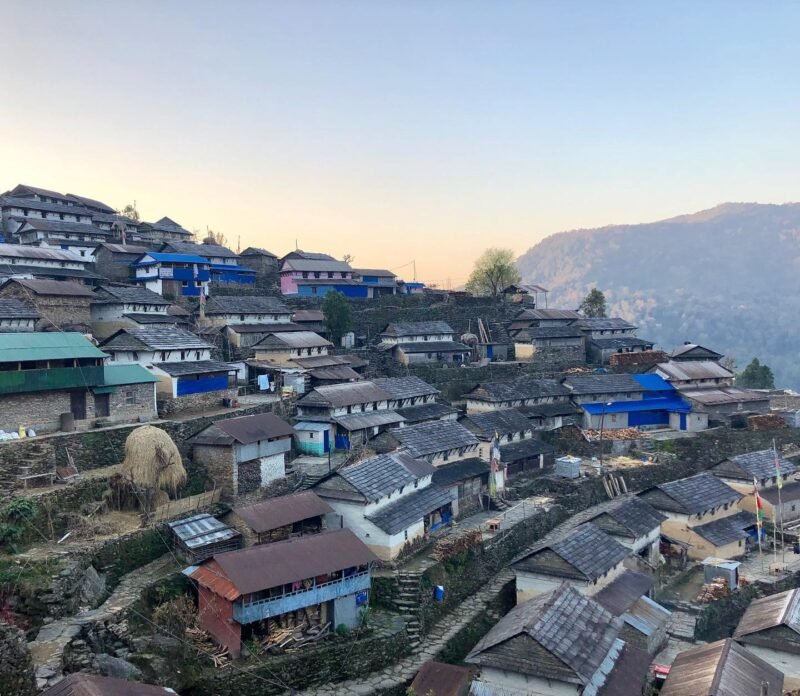Bhujung, the largest Gurung village in Lamjung, is home to around 450–500 stone-and-mud houses, forming a tightly knit settlement steeped in history. Despite its size, the village is remarkably clean and well-maintained, preserving age-old customs while embracing modern innovations like a ropeway system for transporting agricultural goods. Often called a “virgin” or hidden village,” Bhujung remains invisible from a distance, retaining its authenticity and unique charm.

Book Your Trip to Your Destination
Price Per Person: $0
Total: $0
Journey: Kathmandu → Besisahar → Ghalegaun → Bhujung
The journey begins in Kathmandu, Nepal’s bustling capital, with an early morning departure to Besisahar, the district headquarters of Lamjung. The 6–7 hour drive along the Prithvi Highway passes through Thankot, Naubise, and Mugling, then turns north at Dumre toward Besisahar—a lively riverside town that serves as the gateway to Lamjung’s hill villages and trekking routes.
Day 1: Kathmandu to Besisahar (6–7 hours)
- Private Vehicle: Flexible travel with scenic stops along the way.
- Public Bus/Microbus: Frequent services from Gongabu Bus Park, costing NPR 600–800.
- Highlights: Views of the Trishuli and Marshyangdi Rivers, terraced farmland, and occasional Himalayan peaks. Tea stops at Malekhu (famous for fish dishes) and Mugling are popular.
From Besisahar, a 2-hour drive ascends toward Ghalegaun (2,100 m), a well-preserved Gurung village known for its red-roofed stone houses, Himalayan panoramas, and traditional lifestyle. Visitors can explore Koibodhin, Uttarkanya Temple, ancient wells, release pigeons for peace, watch a spirited local football match, or enjoy nostalgic treats like Sunpapri.
The final one-hour descent reveals Bhujung (1,600 m)—a vast settlement hidden until the last approach, where hundreds of stone houses suddenly appear, marking the start of a true cultural immersion.
Arrival in Bhujung: A Hidden Gem
Bhujung is built on the western slope of an eastern hill, divided by a river valley, making it almost invisible from afar. A nearby tea garden signals its presence. At night, it feels like an isolated hamlet, but daylight uncovers a sprawling cluster of homes cascading down the hillside.
Village Structure, Culture & Ethos
From the ward office in Kholasothar-4, panoramic views show 450 clustered houses, including rounded stone homes believed to be over 700 years old. While some modern homes have been built, many elders still wear traditional Gurung attire, keeping ancestral customs alive.
Every Bhadra month, villagers gather for a Bhadau Sabha, a communal meeting to set rules, wage rates, and prices. Commitments are sealed through “Dharma Samatne”, a ritual with a khukuri (traditional knife), blending ancient customs with modern governance.
Wild Honey Hunting: A World-Famous Daring Tradition
Bhujung is globally renowned for its wild honey hunting, a dramatic ritual that draws fascination worldwide. Skilled Gurung honey hunters, known as Mad Honey Harvesters, scale sheer cliffs up to 300 feet high, using 30-meter-long handmade rope or bast ladders secured to rock outcrops. They brave swarming giant Himalayan bees (Apis laboriosa), smoke from fires below, and the risk of fatal falls to collect honeycombs clinging to inaccessible rock faces.
This honey, often called “mad honey” due to its natural hallucinogenic properties from rhododendron nectar, has been used for traditional medicine, rituals, and trade for centuries. The process is communal: villagers chant prayers for safety, offer blessings to cliff spirits, and assist hunters from below with ropes and baskets. Each harvest is a high-risk, high-reward event symbolizing courage, teamwork, and respect for nature.
Economy & Daily Life
In the past, residents trekked 12 days to trade salt and iron, often bartering handmade bamboo goods. Road access only improved in the last 10–15 years, easing trade and travel. Today, a Japan-assisted ropeway system and tractors transport heavy loads efficiently.
Farming remains the primary livelihood, with crops like maize, millet, barley, and rice sustaining families and local trade. Tourism now adds income, with homestays providing authentic Gurung experiences for visitors.
Social Transformation & Empowerment
Decades ago, issues like hunting, gambling, and alcoholism troubled the village. Around 2050 BS, the Annapurna Conservation Area Project (ACAP) helped establish mother’s groups, ban hunting, protect forests, and instill discipline. Today, women lead in dispute resolution, homestay management, and community development.
Preserving Tradition: Rodhi, Dance & Tourism
Traditional Rodhi gatherings, once lively evening events of song and dance, declined but have been revived in daytime formats. Cultural programs and Gurung dances are performed for visitors, maintaining heritage while adapting to modern lifestyles.
Hospitality & Travel Experience
Guests are welcomed with warm greetings, Tika blessings, and heartfelt farewells. Homestays offer cozy accommodations and authentic local meals, allowing travelers to escape modern chaos and immerse themselves in Gurung culture and nature.
Why Bhujung Belongs on Every Traveler’s List
- Ancient Heritage: Over 700 years of culture and architecture preserved.
- Cultural Immersion: Traditional governance, festivals, and Gurung hospitality.
- Balanced Modernity: Ropeway transport and sustainable village practices.
- Natural Beauty: Himalayan foothill setting at 1,600 m, tea gardens, and river valleys.
- Community Resilience: A successful transition from barter trade to sustainable tourism, driven by empowered women.



Leave a Reply